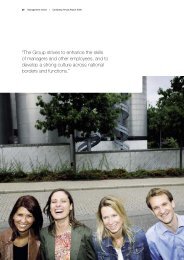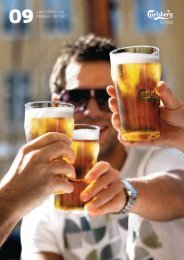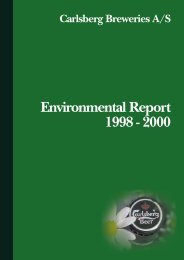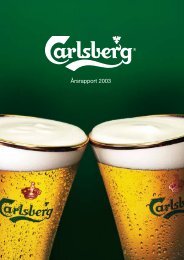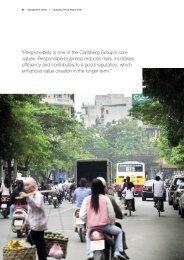Corporate governance - Carlsberg Group
Corporate governance - Carlsberg Group
Corporate governance - Carlsberg Group
You also want an ePaper? Increase the reach of your titles
YUMPU automatically turns print PDFs into web optimized ePapers that Google loves.
42 <strong>Corporate</strong> <strong>governance</strong> / <strong>Carlsberg</strong> Annual Report 2006“<strong>Carlsberg</strong> aims to develop and maintain goodrelations with its stakeholders, because suchrelations are important for the Company’sdevelopment.”
<strong>Carlsberg</strong> Annual Report 2006 / <strong>Corporate</strong> <strong>governance</strong> 43<strong>Corporate</strong> <strong>governance</strong><strong>Carlsberg</strong>’s Board of Directors and Executive Boardstrive constantly to ensure that the <strong>Group</strong>’s managementstructure and control systems are appropriate and workingsatisfactorily. A series of internal procedures havebeen developed and are regularly maintained in order toensure active, reliable and profi table management of thebusiness.With few exceptions, <strong>Carlsberg</strong>’s corporate <strong>governance</strong>complies with the OMX Copenhagen Stock Exchange’srecommendations for good corporate <strong>governance</strong>.These exceptions are presented at the end of this section.The basis for the <strong>Group</strong>’s corporate <strong>governance</strong> includesthe Danish Companies Act, the Danish Financial StatementsAct, IFRS, the Danish Securities Trading Act, theOMX Copenhagen Stock Exchange’s rules and recommendationsfor issuers, the Company’s Articles of Associationand values, and good practice for companies of<strong>Carlsberg</strong>’s size and global reach.Shareholders and <strong>Carlsberg</strong><strong>Carlsberg</strong> aims to provide information and opportunitiesfor dialogue with the Company’s shareholders. Thistakes the form of regular publication of news, interim reportsand annual reports, and General Meetings. TheCompany’s website is continuously updated with publishedinformation. Regular teleconferences and meetingsare also arranged with professional investors.The Board of Directors regularly assesses whether theCompany’s capital structure is in the interests of the<strong>Group</strong> and its shareholders. The overall goal is to ensurea capital structure which supports long-term profi tablegrowth. The capital structure is part of the <strong>Group</strong>’sstrategy.The Company’s Articles of Association contain no limitson ownership or voting rights. Should a bid be made totake over the Company’s shares, the Board of Directorswill consider it in accordance with applicable legislationand the <strong>Carlsberg</strong> Foundation’s Charter.<strong>Carlsberg</strong>’s share capital has been divided into twoclasses for many years. All shares have the same nom-inal value (DKK 20), but while an A-share carries 20votes, a B-share carries two votes but is entitled to apreferential dividend. Both classes of share are listed onthe OMX Copenhagen Stock Exchange, and so investorscan choose which class they wish to invest in. TheBoard of Directors is of the opinion that the division intoA-shares and B-shares, combined with the <strong>Carlsberg</strong>Foundation’s position as majority shareholder, has beenand will remain advantageous for all of the Company’sshareholders, as this structure enables and supports thelong-term development of the business.The General MeetingThe General Meeting is the Company’s supreme governingbody. The Board of Directors attaches importance toshareholders receiving detailed information and an adequatebasis for the decisions taken at the General Meeting.Notice of a General Meeting is given at least eight daysbefore it is held so that shareholders have an opportunityto prepare. All shareholders have the right to take partand to vote in person or by proxy at a General Meeting,cf. the Company’s Articles of Association, and have anopportunity to put forward proposals for consideration.Shareholders may give proxies to the Board of Directorsor others for each individual item on the agenda.Stakeholders and the Company<strong>Carlsberg</strong> aims to develop and maintain good relationswith its stakeholders, because such relations are consideredto be important and positive for the Company’sdevelopment.Against this background, the Company has formulatedpolicies for a number of key areas, such as communications,human resources, the environment, and responsibilityto customers and society in general. One elementof the Board of Directors’ work is to ensure both compliancewith and regular adjustment of these policies torefl ect developments both inside and outside the Company.The communications policy and related procedures areto ensure that information of importance to investors,employees, authorities etc. is made available to them
44 <strong>Corporate</strong> <strong>governance</strong> / <strong>Carlsberg</strong> Annual Report 2006and published in accordance with applicable rules andagreements.Communication with investors and equity analysts ishandled by the Company’s Executive Board, supportedby the Investor Relations department. This dialogue includesa broad programme of activities in Denmark andabroad, and complies with the rules of the OMX CopenhagenStock Exchange. All investor information is publishedsimultaneously in English and Danish, and is alsodistributed directly to shareholders and others who haverequested it immediately following publication.The composition of the Board of DirectorsThe General Meeting elects the Board of Directors. TheBoard of Directors has eight members elected by theGeneral Meeting. It also has four members elected bythe employees in accordance with the Danish CompaniesAct. The employee-elected members have thesame rights and obligations as the members elected bythe General Meeting and are elected for a term of fouryears. The most recent employee elections took place in2006.Thus the Board of Directors has a total of 12 members.The Board of Directors fi nds this number of membersappropriate.Five of the members elected by the General Meeting areaffi liated to the <strong>Carlsberg</strong> Foundation, the Company’sprincipal shareholder, and have an academic background,while three have a business background. Thiscomposition ensures appropriate breadth in the members’approach to their duties, and the Board of Directorsis of the opinion that this helps to ensure high- qualitydeliberation and decisions.The members of the Board of Directors are electedindividually. At each Annual General Meeting the threelongest-serving shareholder-elected members step down.They may be reelected. Members must also step down atthe fi rst General Meeting after reaching the age of 70.When recommending candidates for election at theGeneral Meeting, the Board of Directors distributes inadvance a presentation of each individual candidate’sbackground, relevant competences and any other managerialpositions or demanding positions of responsibility,and the Board of Directors justifi es its recommendationson the basis of the criteria which the Board of Directorshas laid down for recruitment.A description of the composition of the Board of Directorsand the individual members’ particular competenceswith respect to the work of the Board of Directors canbe found in a separate section of this Annual Report.The work of the Board of DirectorsThe Boards of Directors of the Parent Company, <strong>Carlsberg</strong>A/S, and other companies in the <strong>Group</strong> ensure thattheir Executive Boards observe the goals, strategies andbusiness procedures established by the Boards of Directors.Information from the Executive Boards of the variouscompanies is provided systematically at meetings as wellas in written and oral reports. These reports cover suchareas as external developments and the companies’performance, profi tability and fi nancial position.The Board of Directors of <strong>Carlsberg</strong> A/S meets accordingto a set schedule at least six times a year. An annualstrategy meeting is usually held where the Company’svision, goals and strategy are discussed. In between itsordinary meetings, the Board of Directors receives regularwritten information on the Company’s operations andposition, and extraordinary meetings are convened if thesituation calls for it. The Board of Directors held sixmeetings in 2006.The Board of Directors decides on issues such as acquisitions,major investments and divestments, the size andcomposition of the Company’s capital base, long-termobligations, signifi cant policies, control and audit issues,and signifi cant operational matters.The Board of Directors’ Rules of Procedure set out theprocedures for the Executive Board’s reporting to theBoard of Directors and for other communication betweenthe two bodies. The Rules of Procedure are reviewedannually by the Board of Directors and adjustedto the Company’s circumstances as required.The Chairman and Deputy Chairman of the Board ofDirectors constitute the Chairmanship, which, amongother things, organises meetings of the Board of Directorsin cooperation with the Company’s Executive Board.The particular duties of the Chairman and – in his absence– the Deputy Chairman are set out in the Rules ofProcedure.In 2006 the Board of Directors introduced a structuredannual evaluation of its work, results and composition.This evaluation, headed by the Chairman of the Board,also covers the cooperation between the Board of Directorsand the Executive Board, and the work, resultsand composition of the Executive Board.
<strong>Carlsberg</strong> Annual Report 2006 / <strong>Corporate</strong> <strong>governance</strong> 45The Board of Directors regularly – and at least once ayear – considers whether there is reason to update orstrengthen its members’ expertise with respect to theirduties.The Board of Directors may appoint committees forspecifi c purposes but has not yet found it necessary toestablish any permanent committees.None of the members of the Board of Directors areinvolved in the executive management of the <strong>Group</strong>.The Executive BoardThe Board of Directors appoints the CEO and othermembers of the Executive Board. Led by the CEO, theExecutive Board is responsible for the preparation andimplementation of strategic plans.The members of the Executive Board are not membersof the Board of Directors but do attend meetings of theBoard of Directors.RemunerationIn order to attract and retain managerial expertise, theremuneration of the members of the Executive Boardand other senior executives is determined on the basisof the work they do, the value they create, and conditionsat comparable companies. The remuneration of theExecutive Board is presented in the notes to the fi nancialstatements.This remuneration includes incentive programmes whichare to help align the interests of the Company’s managementand shareholders, as these programmes supportboth short-term and long-term goals.A share option programme for the Executive Board anda number of other senior executives in the <strong>Group</strong> hasbeen running since 2001. The programme entitles theseindividuals to purchase B-shares in <strong>Carlsberg</strong> A/S betweenthree and eight years after the options aregranted. The exercise price is the market price duringthe fi rst fi ve days following the publication of the profi tstatement for the year.The number and value of share options granted and outstandingare presented in the notes to the fi nancialstatements.The option programme is supplemented with performance-relatedbonus schemes covering a proportion ofthe <strong>Group</strong>’s salaried employees.The Board of Directors of <strong>Carlsberg</strong> A/S is not includedin the Company’s incentive programmes.The <strong>Carlsberg</strong> FoundationThe <strong>Carlsberg</strong> Foundation’s (“the Foundation”) holdingin <strong>Carlsberg</strong> A/S (“the Company”) is long-term andstrategic. The Foundation is therefore an active, demandingbut also supportive shareholder. The Foundationsupports the efforts of <strong>Carlsberg</strong>’s managementto create value for shareholders and other stakeholdersby furthering the Company’s growth and strengtheningits profitability.The Foundation is required by its Charter to hold atleast 51% of the Company’s share capital. At the endof 2006 the Foundation held 51.3% (excluding treasuryshares). Due to the combination of A-shares andB-shares held by the Foundation, it had 79% of thevotes at that same time. The Foundation’s ExecutiveBoard makes up an important part of <strong>Carlsberg</strong> A/S’Board of Directors, of which the Chairman of theFoundation is also Chairman.The Foundation’s Charter and Statutes lay down anumber of obligations and rights with respect to<strong>Carlsberg</strong> A/S. Thus the <strong>Carlsberg</strong> Laboratory, whichis part of the Foundation and an independent unitwithin the <strong>Carlsberg</strong> Research Center, receives a grantfrom the Foundation, but the Company is required tomeet its running costs. The Company also has an obligationto preserve various historical buildings on thebrewery’s site in Valby, Copenhagen.Further information about the <strong>Carlsberg</strong> Foundationcan be found at www.carlsbergfondet.dk.
46 <strong>Corporate</strong> <strong>governance</strong> / <strong>Carlsberg</strong> Annual Report 2006Risk managementThe Board of Directors reviews the overall risk exposureand the individual risk factors associated with the <strong>Group</strong>’sactivities (see separate section of this Annual Report).Such reviews are performed as required and at leastonce a year.The Board of Directors adopts guidelines for key areasof risk, monitors developments and ensures that plansare in place for the management of individual risk factors,which include commercial and fi nancial risks, insuranceand environmental matters, and compliancewith competition legislation.AuditingTo safeguard the interests of shareholders and the generalpublic, an independent auditor is appointed at theAnnual General Meeting following a recommendationfrom the Board of Directors. Before making its recommendation,the Board of Directors undertakes a criticalevaluation of the auditor’s independence, competenceetc.The auditor submits a report to the assembled Board ofDirectors twice a year and also immediately after identifyingany issues of which the Board of Directors shouldbe informed.An Internal Audit function was set up in 2006 to supportmanagement’s day-to-day control work.The OMX Copenhagen Stock Exchange’srecommendationsSince 2005 a number of recommendations for goodcorporate <strong>governance</strong> have formed part of the rules forcompanies listed on the OMX Copenhagen Stock Exchange.As in other European countries, companiesmust either comply with the recommendations or explaindepartures from them.As discussed above, <strong>Carlsberg</strong>’s corporate <strong>governance</strong>largely complies with these recommendations, but with afew exceptions. These are presented and explained inthe following (references in brackets are to the relevantsections of the recommendations):<strong>Carlsberg</strong>’s departures from the OMX Copenhagen Stock Exchange’s recommendationsIt is recommended that at least half of the members of the Board ofDirectors elected by the General Meeting be independent. Any personwho has close links with a company’s main shareholder is not regardedas independent (V, 4a)Five of the eight members of <strong>Carlsberg</strong>’s Board of Directors electedby the General Meeting have close links with the Company’s principalshareholder, the <strong>Carlsberg</strong> Foundation, as they make up the Foundation’sExecutive Board. Thus these members are not independent asdefined in the recommendations. This has been the situation for manyyears. The Board of Directors is of the opinion that the combination ofmembers with different academic backgrounds and members with abusiness background ensures appropriate breadth in the members’approach to their duties and helps to ensure high-quality deliberationand decisions.It is recommended that information be provided on managerial positionsand directorships at Danish and foreign companies and anyother demanding organisational tasks performed by members of theBoard of Directors (V, 4d, 2)In accordance with section 107 paragraph 1 of the Danish FinancialStatements Act, <strong>Carlsberg</strong> provides information in its Annual Reporton managerial positions at other Danish companies held by membersof the Board of Directors. Information is also provided on other significantmanagerial positions and other organisational tasks performed inDenmark and abroad.It is recommended that information be provided on shares and optionsheld by the individual members of the Board of Directors in thecompany in question, and on any changes in these holdings duringthe financial year (V, 4d, 3)The members of the Board of Directors do not hold any options in theCompany. The section on shareholder information in the Annual Reportcontains information on the Board of Directors’ total holding ofshares in the Company, but the Board of Directors does not considerit useful to disclose information on individual members’ holdings.It is recommended that the annual report contain detailed informationon remuneration policy and the remuneration of the individual membersof the Board of Directors and the Executive Board (VI, 2-3 and 6)<strong>Carlsberg</strong>’s Annual Report presents information on the <strong>Group</strong>’s remunerationschemes, the components of remuneration, and the total remunerationof both the Board of Directors and the Executive Board,cf. section 69 of the Danish Financial Statements Act. It is not currentlyconsidered useful or reasonable to publish information on theremuneration of individuals. Remuneration schemes (including severancearrangements) and remuneration are believed to be in line withcomparable companies.It is recommended that the exercise price for options granted behigher than the market price at the time they are granted (VI, 4)In the current scheme, the exercise price corresponds to the marketprice during the first five days following the publication of the profitstatement for the year.



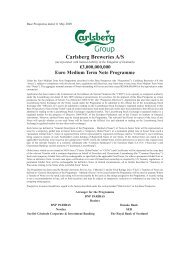
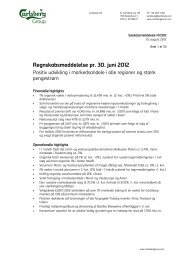
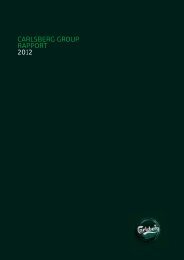
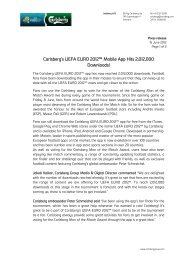
![[Name and Address] - Carlsberg Group](https://img.yumpu.com/49766377/1/184x260/name-and-address-carlsberg-group.jpg?quality=85)

![[Name and Address] - Carlsberg Group](https://img.yumpu.com/49015962/1/184x260/name-and-address-carlsberg-group.jpg?quality=85)
